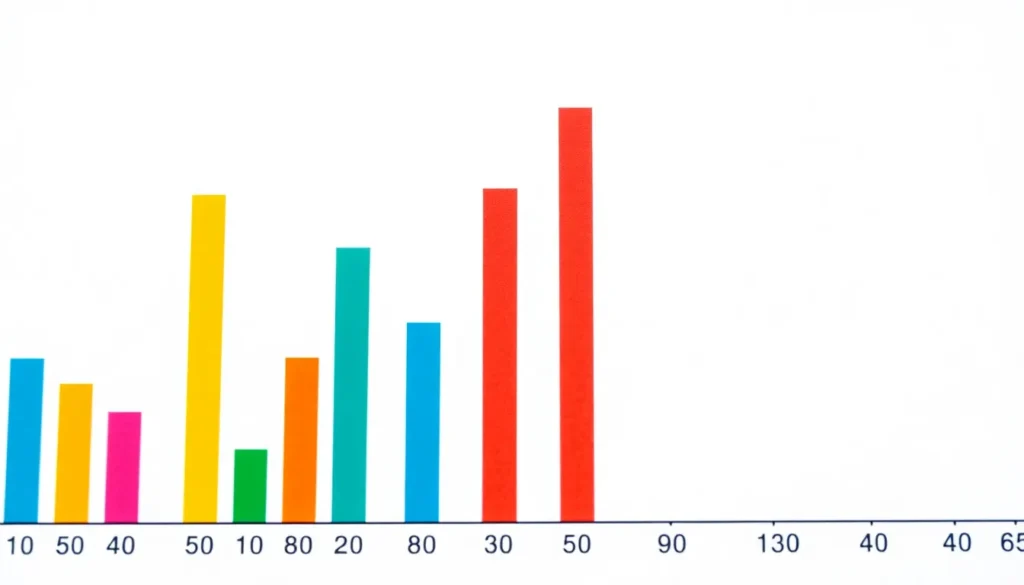Table of Contents
ToggleEver found yourself drowning in a sea of numbers, wondering how on earth to make sense of them? Fear not! The stem and leaf plot is here to rescue you from numerical chaos. This quirky little chart isn’t just a fun way to display data; it’s a powerful tool that can help anyone—whether you’re a student, teacher, or just a curious mind—understand and analyze information with ease.
What Is a Stem and Leaf Plot?
A stem and leaf plot organizes numerical data to display its shape and distribution clearly. This graphical tool helps individuals analyze data efficiently.
Definition
A stem and leaf plot consists of two parts: stems and leaves. Stems represent the leading digits of the data values, while leaves denote the trailing digits. For example, in the number 45, the stem is 4, and the leaf is 5. This method preserves the original data values while providing a compact visual representation. As a result, it allows viewers to see patterns and groupings within the dataset easily.
Purpose
The primary purpose of a stem and leaf plot is to facilitate data analysis. It serves as a bridge between raw data and graphical representation. Individuals can identify shapes or outliers quickly when using a stem and leaf plot. Moreover, this tool enables quick comparisons of different data sets. By maintaining the integrity of the data, it highlights important numerical relationships. Overall, the stem and leaf plot stands out as an effective means for summarizing and understanding numerical information.
Components of a Stem and Leaf Plot

A stem and leaf plot comprises two main components: stems and leaves. These elements work together to create a comprehensive visual representation of data, making it easier to analyze numerical information.
Stems
Stems represent the leading digits in data values. For example, in the number 45, the 4 forms the stem. Each unique stem groups together several leaves that correspond to its trailing digits. Stems create a structure that organizes the data, allowing viewers to quickly assess frequency and distribution. Several stems can exist in a plot, especially when data ranges are wider, offering a clearer overview of the dataset.
Leaves
Leaves denote the trailing digits of each data value. In the previous example of 45, the 5 is the leaf. Each leaf connects to its respective stem, providing detailed information about individual data points. Leaves are typically listed in ascending order next to their corresponding stems for easy interpretation. This arrangement helps visualize data dispersion, making it convenient to spot trends, clusters, or outliers in the dataset.
How to Create a Stem and Leaf Plot
Creating a stem and leaf plot involves simple steps that anyone can follow. This method effectively organizes numerical data and highlights patterns.
Step-by-Step Guide
- Identify Data Values: Start with a dataset. For example, consider the numbers 23, 25, 24, 30, and 31.
- Separate Stems and Leaves: Determine the leading digits as stems. For 23, the stem is 2, and the leaf is 3.
- Group Stems: List stems in a vertical column, ensuring each unique stem appears once.
- Arrange Leaves: Next to each stem, write the corresponding leaves in ascending order.
- Finalize the Plot: Format the plot neatly, confirming that all stems and leaves align correctly. This structure enhances readability and analysis.
Example
Consider a dataset: 12, 14, 15, 22, and 23. Here’s how it translates into a stem and leaf plot:
- Stem: 1
|
Leaves: 2, 4, 5
- Stem: 2
|
Leaves: 2, 3
This representation clearly shows the distribution of the dataset. As numbers increase, the leaves remain organized, making patterns easy to spot.
Interpreting a Stem and Leaf Plot
Interpreting a stem and leaf plot requires careful attention to data organization. Each stem reveals crucial information about the leading digits, while leaves specify the trailing digits.
Analyzing Data
Analyzing data through a stem and leaf plot involves examining the arrangement of stems and leaves. This method enables quick assessments of frequency and distribution. For instance, if several leaves appear next to a specific stem, it indicates a concentration of values within that range. Successful analysis allows for an understanding of how data points cluster, showing where most data values lie. Observing stems with many leaves suggests high frequency, while those with few leaves indicates lower occurrence. Recognizing these patterns helps highlight significant areas in the dataset.
Identifying Patterns
Identifying patterns in a stem and leaf plot enhances data interpretation. Analyzing the shape of the plot reveals trends, clusters, or outliers within the dataset. A symmetrical distribution of leaves suggests a normal or bell-shaped curve, while skewness signals a deviation from symmetry, indicating possible anomalies. It’s common to spot clusters, where multiple values group closely together, which may signal important insights. Outliers, or values that stray far from other leaves, require attention as they can represent errors or unique circumstances. By recognizing these elements, one gains a clearer understanding of the underlying data trends.
The stem and leaf plot stands out as a practical method for visualizing numerical data. Its unique structure allows for easy identification of trends and patterns while preserving the original data’s integrity. This makes it an invaluable tool for students and professionals alike.
By mastering the creation and interpretation of stem and leaf plots, individuals can enhance their data analysis skills. Whether for academic purposes or real-world applications, understanding this technique opens up new avenues for insight and decision-making. Embracing such tools fosters a deeper appreciation for data and its potential to inform choices.




